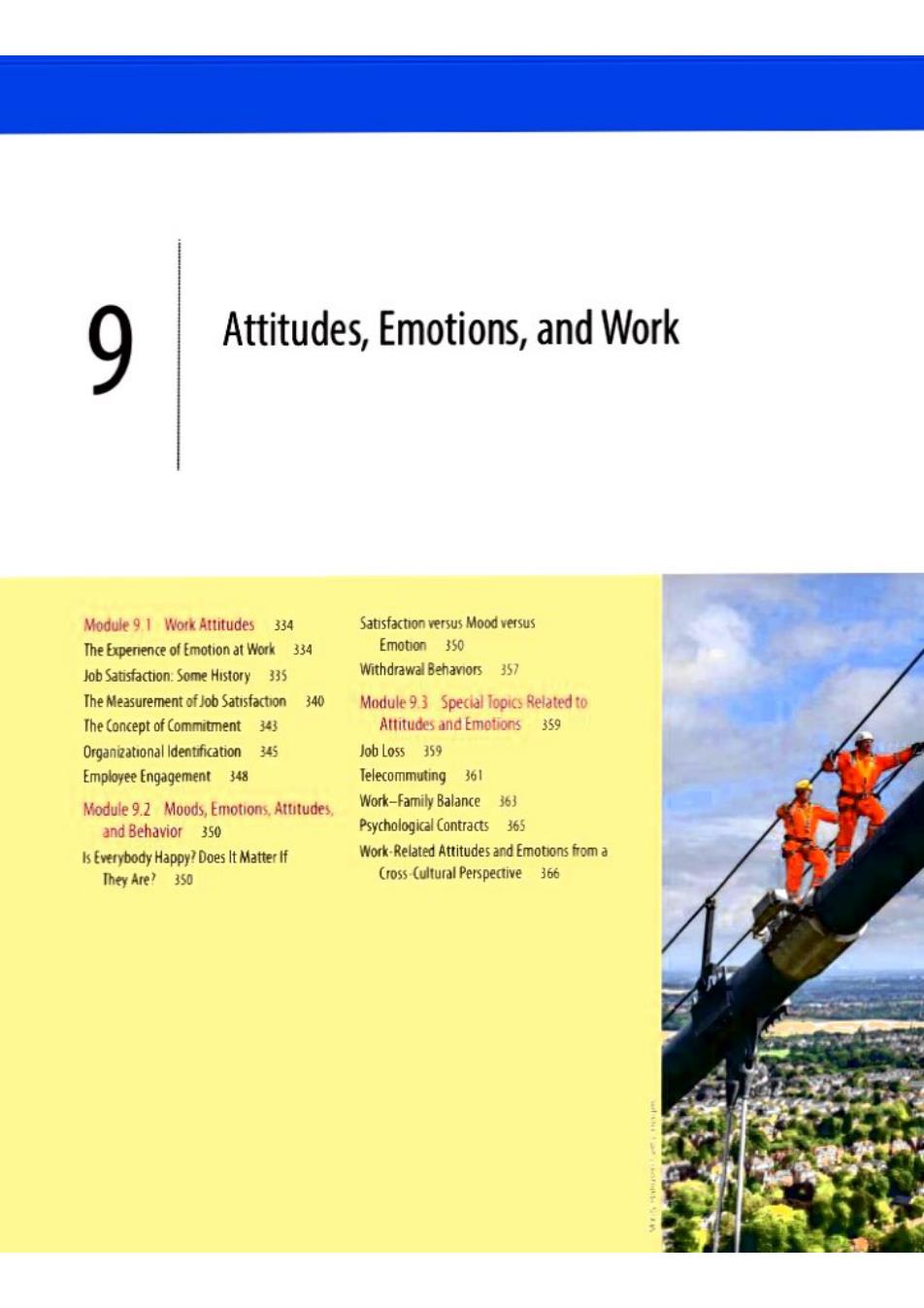
9 Attitudes,Emotions,and Work Module 9.1 Work Attitudes 334 Satisfaction versus Mood versus The Experience of Emotion at Work 334 Emotion 350 Job Satisfaction:Some History 335 Withdrawal Behavors 357 The Measurement of Job Satisfaction 340 Module93 Special Topics Related to The Concept of Commitment 343 Attitudes and Emotions 359 Organizational ldentification 345 Job Loss 359 Employee Engagement 348 Telecommuting 361 Module 9.2 Moods,Emotions.Attitudes Work-Family Balance 363 and Behavior 350 Psychological Contracts 365 Is Everybody Happy?Does It Matter lf Work-Related Attitudes and Emotions from a They Are?350 Cross-Cultural Perspective 366
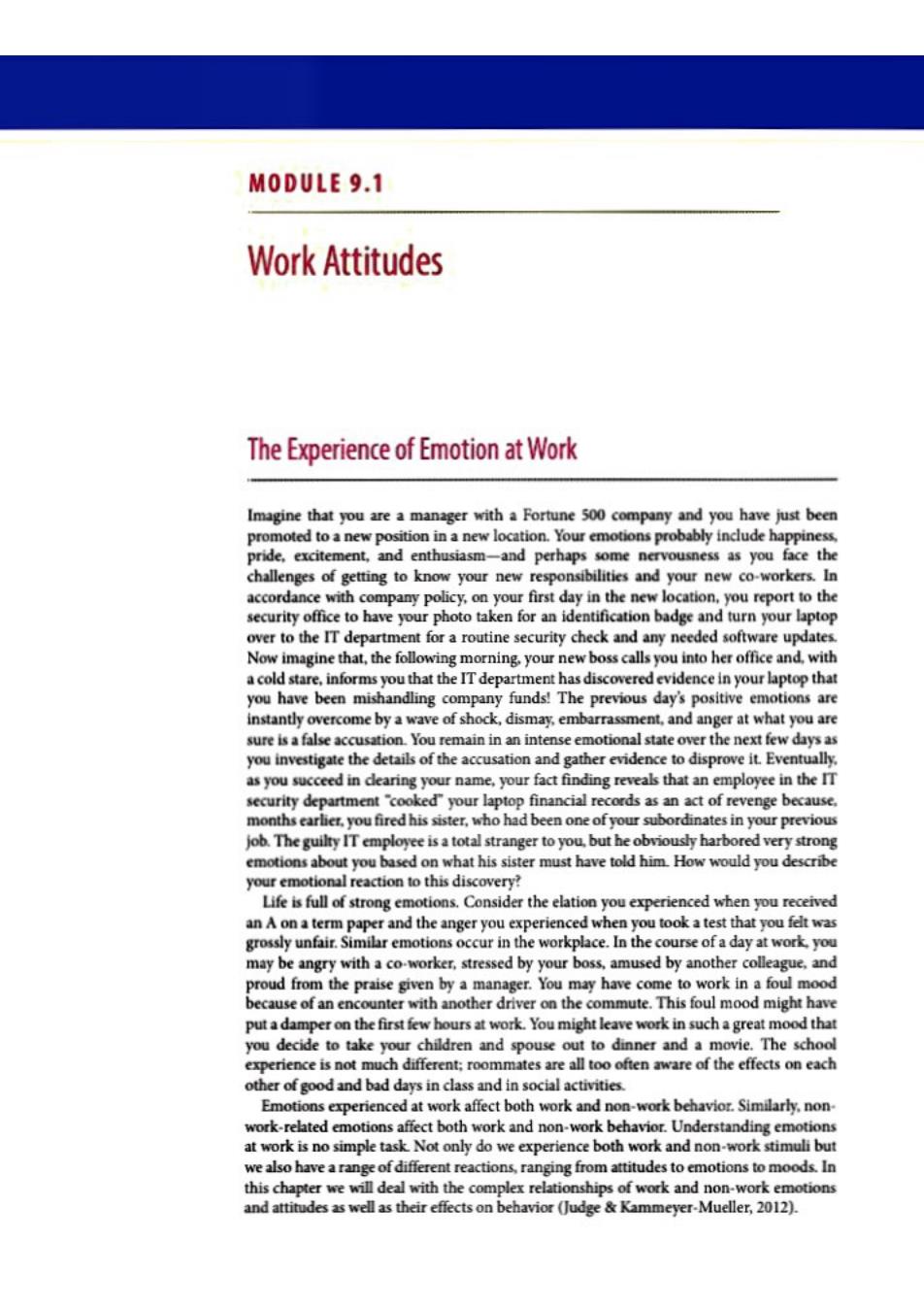
MODULE 9.1 Work Attitudes The Experience of Emotion at Work Imagine that you are a manager with a Fortune 500 company and you have just been promoted to a new position in a new location.Your emotions probably include happiness. pride,excitement,and enthusiasm-and perhaps some nervousness as you face the challenges of getting to know your new responsibilities and your new co-workers.In accordance with company policy,on your first day in the new location,you report to the security office to have your photo taken for an identification badge and turn your laptop over to the IT department for a routine security check and any needed software updates. Now imagine that,the following morning.your new boss calls you into her office and,with a cold stare,informs you that the IT department has discovered evidence in your laptop that you have been mishandling company funds!The previous day's positive emotions are instantly overcome by a wave of shock,dismay,embarrassment,and anger at what you are sure is a false accusation.You remain in an intense emotional state over the next few days as you investigate the details of the accusation and gather evidence to disprove it.Eventually. as you succeed in dearing your name,your fact finding reveals that an employee in the IT security department cooked"your laptop financial records as an act of revenge because. months earlier.you fired his sister,who had been one of your subordinates in your previous job.The guilty IT employee is a total stranger to you,but he obviously harbored very strong emotions about you based on what his sister must have told him.How would you describe your emotional reaction to this discovery? Life is full of strong emotions.Consider the elation you experienced when you received an A on a term paper and the anger you experienced when you took a test that you felt was grossly unfair.Similar emotions occur in the workplace.In the course of a day at work.you may be angry with a co-worker,stressed by your boss,amused by another colleague,and proud from the praise given by a manager.You may have come to work in a foul mood because of an encounter with another driver on the commute.This foul mood might have put a damper on the first few hours at work.You might leave work in such a great mood that you decide to take your children and spouse out to dinner and a movie.The school experience is not much different:roommates are all too often aware of the effects on each other of good and bad days in class and in social activities. Emotions experienced at work affect both work and non-work behavior.Similarly.non. work-related emotions affect both work and non-work behavior.Understanding emotions at work is no simple task Not only do we experience both work and non-work stimuli but we also have a range of different reactions,ranging from attitudes to emotions to moods.In this chapter we will deal with the complex relationships of work and non-work emotions and attitudes as well as their effects on behavior (Judge Kammeyer-Mueller,2012)

9.1 Work Attitudes 335 Job Satisfaction:Some History The Early Period of Job Satisfaction Research In the mid-1920s,Elton Mayo,an Australian psychologist,introduced the concept of emo- tions into mainstream American I-0 psychology.He argued that factory work resulted in various negative emotions such as anger,fear,suspicion,lowered performance.and increased illness (Mayo,1923).This in turn led to the development of labor unions and worker unrest.(It was no accident that Mayo identified labor unions as the pathological result of job dissatisfaction.He had been actively opposing labor unions in his native Australia long before he arrived in the United States [Griffin,Landy,Mayocchi.2002]) Until this point,there had been little interest among psychologists or managers in the hap- piness of workers.It was assumed that workers cared only about wages and that as long as they were paid adequately,they would be happy.There were occasional surveys of worker satisfaction,but the surveys asked managers about the happiness of the workers rather than asking the workers themselves(Houser,1927). In the early 1930s,two very different research projects breathed life into the concept of job satisfaction.The first was a survey of all the working adults in a small town in Job satisfaction Pastive Pennsylvania.Robert Hoppock(1935)was interested in the answer to two questions How attu血e emotianal state happy were workers,and were workers in some occupations happier than workers in other wul相g from the apprasal occupations?He discovered that only 12 percent of workers could be classified as dissatis. fied.He also found wide variations among individuals within occupational groupings nev. ertheless,workers in some occupational groups (e.g.,professionals and managers)were,on the whole,happier than those in other categories (e.g.unskilled manual laborers).These findings suggested that both job-related and individual differences variables might influ- ence job satisfaction. The second research project was begun at the Hawthorne plant of the Western Electric Company in Cicero,Illinois,in the late 1920s (Roethlisberger Dickson.1939).As you may recall from our discussion in Chapter 1.the purpose of the Hawthorne studies was to examine the relationship between various physical aspects of the work environment (light. ing.workday length,the timing of rest breaks)and productivity.The findings suggested that the perceptions of workers had a greater effect on productivity than the actual physical working conditions. More surprisingly.they also suggested that with almost all of the experimental conditions the researchers introduced. production improved.When illumina- tion was reduced virtually to the level of candlelight,production improved.When the length of the workday was increased. production improved.When rest pauses were eliminated,production improved. These results were so unexpected that the researchers followed up the experiments with extensive interviews and an exami- nation of workers'diaries in an attempt to determine why the reduced illumination Job satisfaction is a positive emotonal state that can result from positive and longer work periods did not have the interactions with one's coworkers

336 Chapter9 Attitudes,Emotions,andWork hypothesized effect of reducing productivity.The researchers discovered that because of the experiment,the workers received considerably more attention from their supervisors and managers than they had previously.This increased attention was viewed positively by the workers and may explain why attitudes toward supervision improved.The improved atti. tudes of workers toward supervisors as a result of the increased attention appeared,in tum. to be responsible for the increase in productivity.This led to the introduction of a new term Hawthome effect into the literature of social and industrial psychology:the Hawthorne effect,meaning a A chang单n behavier道 change in behavior or attitudes that was the simple result of increased attention. 4td相that was the smpl地 At the time this research was reported,the general concusion drawn by I-0 psychologists result of inceased attention was that morale and production seemed to be closely linked.As we will see later in the chapter,this condlusion was wrong Nevertheless,both researchers and managers were quick to embrace this conclusion,and it has been hard to dispel.The Hawthome study results have been analyzed and reanalyzed,interpreted and reinterpreted,and many different theories have been proposed to account for the surprising results(Landsberger,1958).But one thing is beyond dispute Following dosely on the heels of Mayo's early research on the effect of factory work on emotions and the discovery of individual differences in satisfaction by Hoppock.the Hawthorne studies galvanized social scientists and gave impetus to the ttitudes Relativ时stable study of worker attitudes and the new construct of job satisfaction. fengs rbeliefs that are The years between 1935 and 1955 were very active for job satisfaction research,largely drected tward speafic because satisfaction was thought to be closely linked to two outcomes very important to w0气9所,次再 复ahw动布 industry:the prevention of labor unrest in the form of strikes,and productivity.The idea was that if an employer could keep worker morale high,the company would be strike-free and profitable.Most attempts to measure satisfaction asked workers about their most important needs and the extent to which those needs were being met.It was believed that the greater the extent to which important needs were met,the greater would be worker satisfaction (Schaffer,1953).In addition,social psychology was emerging during this period as a specialty within psychology.Social psychologists became very interested in atti- tudes of all sorts,and attitudes toward work represented a good integration of the theories of social psychologists with the interests of industrial psychologists. In the late 1950s,two reviews of the research conducted to that point came to very differ- ent condusions.Brayfield and Crockett(1955)concluded that there was little evidence of any substantial connection between satisfaction and performance.In contrast,Herzberg. Mausner,Peterson.and Capwell (1957)concluded that there was a connection between satisfaction and at least some work behaviors,particularly absenteeism and turnover.This led to the introduction ofone of the first modern theories of job satisfaction,the two-factor theory (Herzberg,Mausner,Snyderman,1959).Recall from Chapter 8 that,according to Herzberg.job satisfaction was the result of intrinsic job characteristics (eg.interesting work.challenge),whereas job dissatisfaction was the result of extrinsic characteristics(e.g.. pay.working conditions).Herzberg proposed that extrinsic factors satisfied "hyglene" needs and intrinsic factors satisfied "motivator"needs.This theory resulted in a flurry of activity.but eventually the theory was rejected on both logical and empirical grounds (Ewen.Smith.Hulin,Locke,1966:King.1970). Antecedents and Consequences of Job Satisfaction lob satisfaction research between 1935 and 1990 has been characterized as atheoretical (Brief&Weiss,2002).This criticism has been leveled in part because researchers depended on statistical analyses as a replacement for theory.They looked for correlations between reports of job satisfaction and observable aspects of work The best example is pay.Studies would examine the relationships among desired levels of pay,observed levels of pay,and reported job satisfaction(Sweeney McFarlin,2005:Williams,McDaniel,Nguyen,2006)
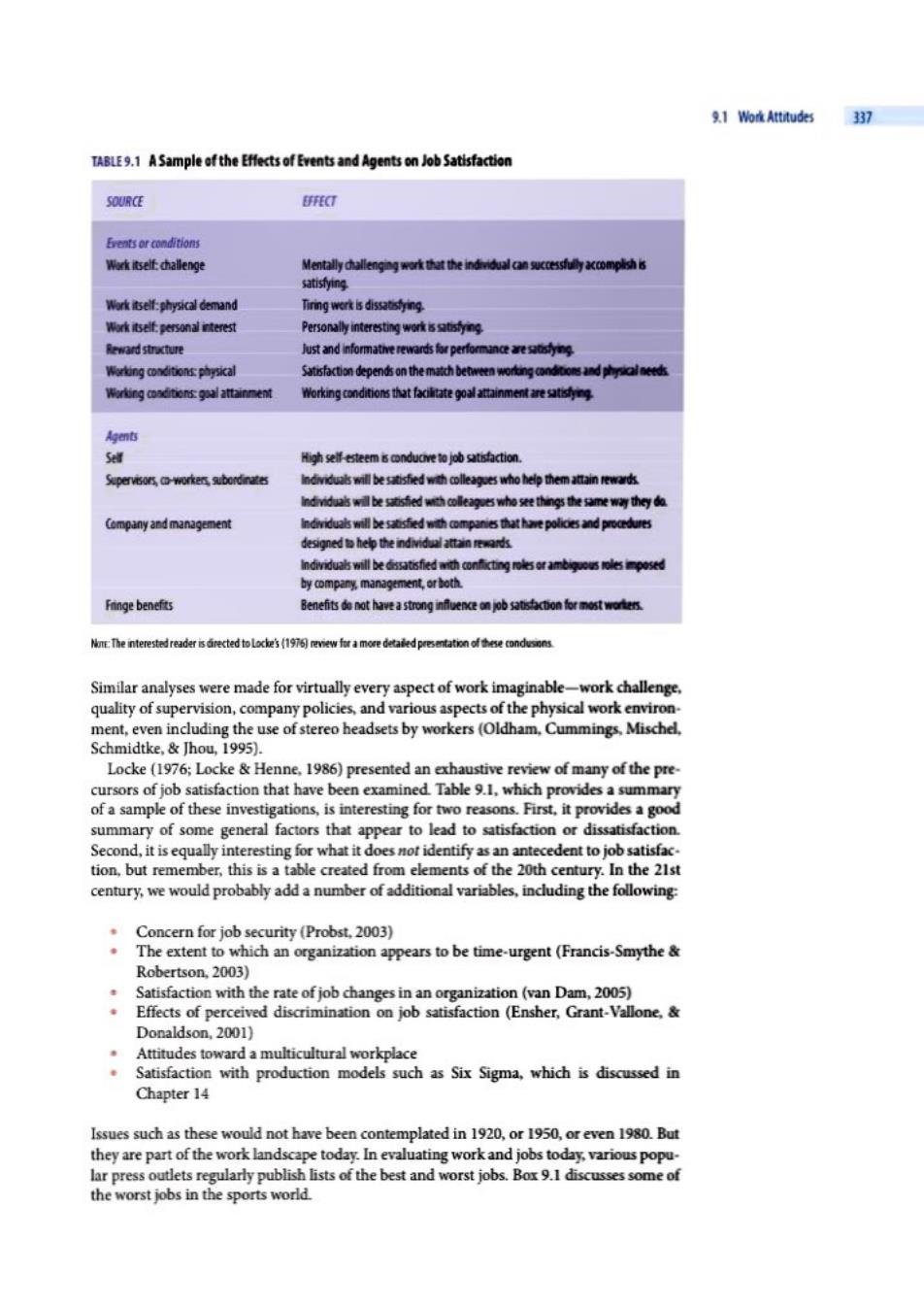
1%kAttitud好 337 TABLE9.1 ASample of the Effects of Events and Agents on Job Satisfaction SOURCE d Events or conditions Wkitsef:challenge Mentally alengngkthat the indiidual can sucesyaccomplishis satisfying Wark itself:physical demand Tirng wrk is dissatng Mork itselt ge都onal interes红t Personally interesting work is satistying Reward structure Just and informative rewards for perfommancer Working conditions physical Satisfaction depends on the math betweenwrngandphcd Warking conditions goal attainment Working conditions that facilitate goal attainment are satisying. 与anb Sel High self esteem is conducive to job satisfaction. Seperviso然,-worke蓝bcd钻 Individuals will be satisfied wth colleagues who help them attain rewards rdd当wb比5ied台colleag名who see things the samew海hy包 Company and management Individuals will be sasedh companies that hve polidesand procdures designed he中he individuattd Individuaswill betsfedthconcngrosoessed by company,management,or both Frnge benefts Benefitsd not have a stronginuenenjobsatforstws N:The interested reader is directed toLocke's(197)review for a more detaled peesentation of these condusns Similar analyses were made for virtually every aspect of work imaginable-work challenge, quality of supervision,company policies,and various aspects of the physical work environ. ment,even including the use of stereo headsets by workers(Oldham.Cummings,Mischel. Schmidtke,Thou.1995). Locke (1976;Locke Henne,1986)presented an exhaustive review of many of the pre- cursors of job satisfaction that have been examined.Table 9.1,which provides a summary of a sample of these investigations,is interesting for two reasons.First,it provides a good summary of some general factors that appear to lead to satisfaction or dissatisfaction. Second,it is equally interesting for what it does not identify as an antecedent to job satisfac. tion,but remember,this is a table created from elements of the 20th century.In the 21st century,we would probably add a number of additional variables,including the following: Concern for job security (Probst.2003) The extent to which an organization appears to be time-urgent(Francis-Smythe Robertson,2003) Satisfaction with the rate of job changes in an organization(van Dam,2005) Effects of perceived discrimination on job satisfaction(Ensher,Grant-Vallone, Donaldson,2001) Attitudes toward a multicultural workplace Satisfaction with production models such as Six Sigma,which is discussed in Chapter 14 Issues such as these would not have been contemplated in 1920,or 1950,or even 1980.But they are part of the work landscape today.In evaluating work and jobs today,various popu- lar press outlets regularly publish lists of the best and worst jobs.Box9.1 discusses some of the worst jobs in the sports world
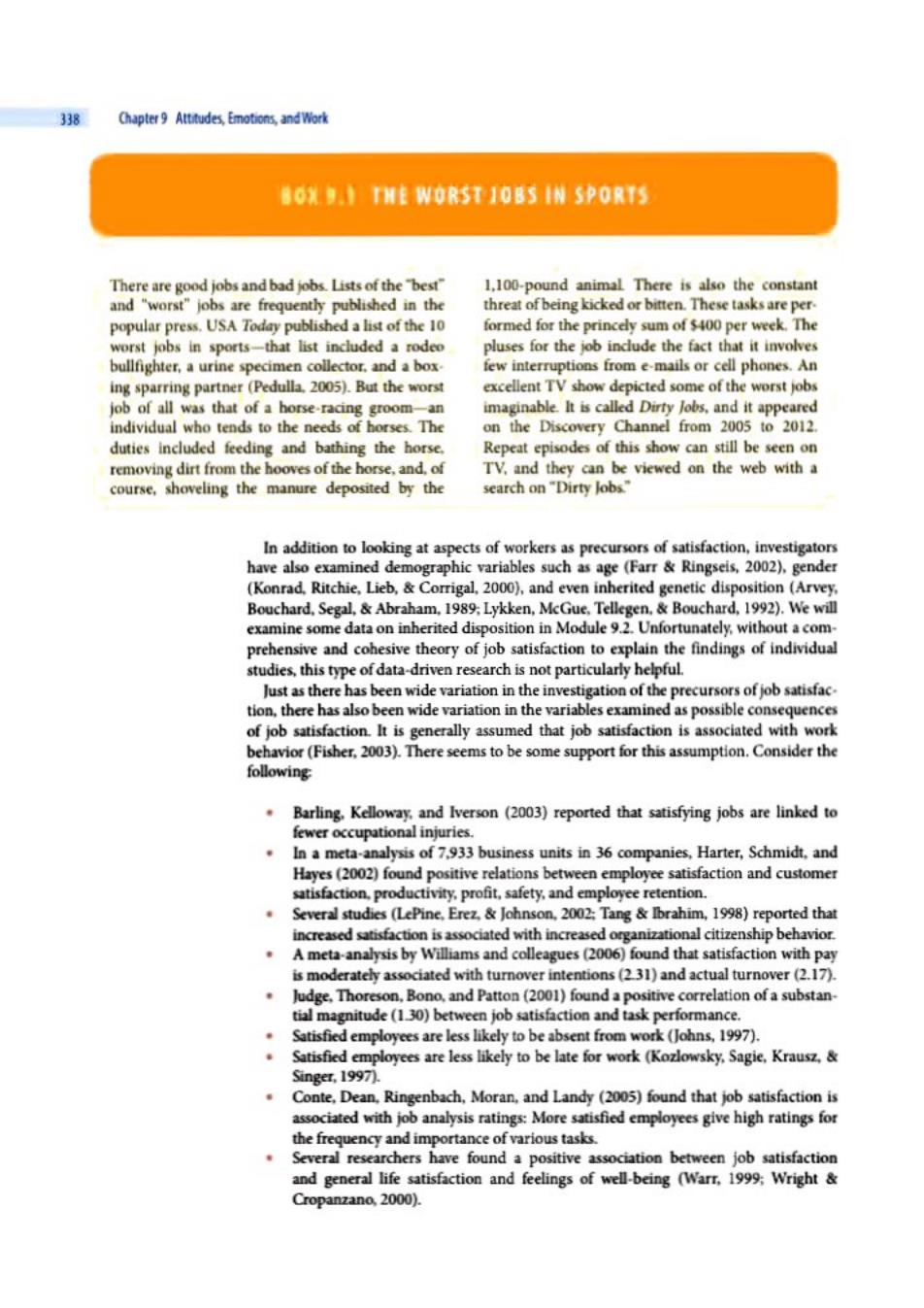
338 Chapter9 Attitudes,Emotions,andWork BOX 9.THE WORST 10BS IN SPORTS There are good jobs and bad jobs.Lists of the best" 1.100-pound animal There is also the constant and "worst"jobs are frequently published in the threat of being kicked or bitten.These tasks are per. popular press.USA Today published a list of the 10 formed for the princely sum of $400 per week.The worst jobs in sports-that list included a rodeo pluses for the job indude the fact that it involves bullfighter,a urine specimen collector.and a box. few interruptions from e-mails or cell phones.An ing sparring partner (Pedulla.2005).But the worst excellent TV show depicted some of the worst jobs job of all was that of a horse-racing groom-an imaginable.It is called Dirty Jobs,and it appeared individual who tends to the needs of horses.The on the Discovery Channel from 2005 to 2012. duties included feeding and bathing the horse. Repeat episodes of this show can still be seen on removing dirt from the hooves of the horse.and.of TV.and they can be viewed on the web with a course,shoveling the manure deposited by the search on"Dirty lobs." In addition to looking at aspects of workers as precursors of satisfaction,investigators have also examined demographic variables such as age (Farr Ringseis,2002).gender (Konrad.Ritchie,Lieb,Corrigal,2000),and even inherited genetic disposition (Arvey. Bouchard.Segal,Abraham.1989:Lykken,McGue,Tellegen.Bouchard,1992).We will examine some data on inherited disposition in Module 9.2.Unfortunately,without a com- prehensive and cohesive theory of job satisfaction to explain the findings of individual studies,this type of data-driven research is not particularly helpful. Just as there has been wide variation in the investigation of the precursors of job satisfac. tion,there has also been wide variation in the variables examined as possible consequences of job satisfaction.It is generally assumed that job satisfaction is associated with work behavior(Fisher,2003).There seems to be some support for this assumption.Consider the following .Barling.Kelloway.and Iverson (2003)reported that satisfying jobs are linked to fewer occupational injuries. In a meta-analysis of 7,933 business units in 36 companies,Harter,Schmidt,and Hayes(2002)found positive relations between employee satisfaction and customer satisfaction.productivity.profit,safety,and employee retention. Several studies (LePine.Erez.Johnson,2002:Tang Ibrahim,1998)reported that increased satisfaction is associated with increased organizational citizenship behavior A meta-analysis by Williams and colleagues (2006)found that satisfaction with pay is moderately associated with turnover intentions (231)and actual turnover (2.17). Judge,Thoreson,Bono,and Patton (2001)found a positive correlation of a substan- tial magnitude (130)between job satisfaction and task performance. Satisfied employees are less likely to be absent from work (Johns,1997). Satisfied employees are less likely to be late for work (Kozlowsky,Sagie,Krausz, Singer,1997). Conte,Dean.Ringenbach,Moran,and Landy (2005)found that job satisfaction is associated with job analysis ratings:More satisfied employees give high ratings for the frequency and importance of various tasks. Several researchers have found a positive association between job satisfaction and general life satisfaction and feelings of well-being (Warr,1999;Wright Cropanzano,2000)
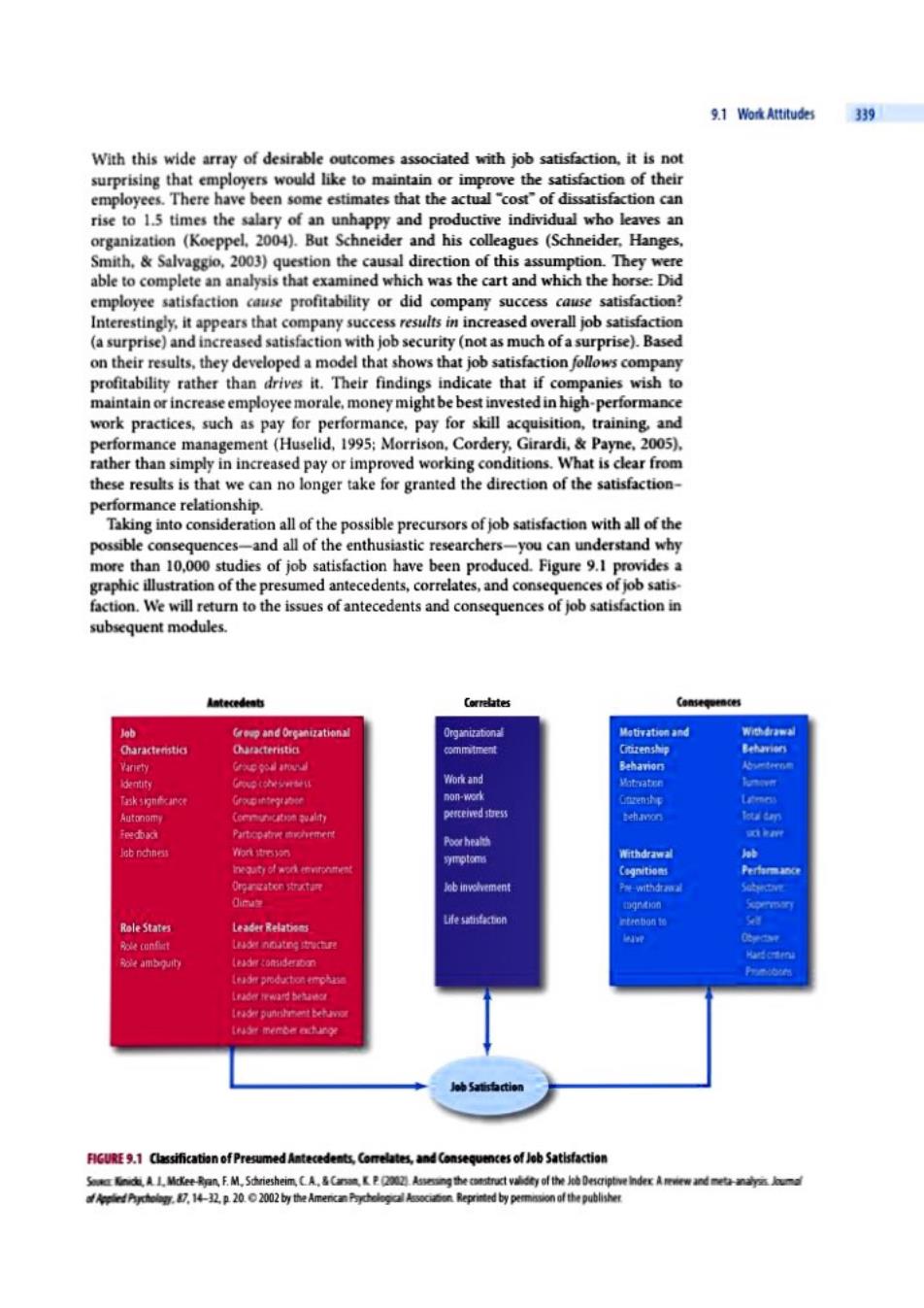
9.1 Work Attitudes 339 With this wide array of desirable outcomes associated with job satisfaction.it is not surprising that employers would like to maintain or improve the satisfaction of their employees.There have been some estimates that the actual "cost"of dissatisfaction can rise to 1.5 times the salary of an unhappy and productive individual who leaves an organization (Koeppel.2004).But Schneider and his colleagues(Schneider.Hanges. Smith.Salvaggio,2003)question the causal direction of this assumption.They were able to complete an analysis that examined which was the cart and which the horse:Did employee satisfaction cause profitability or did company success cause satisfaction? Interestingly,it appears that company success results in increased overall job satisfaction (a surprise)and increased satisfaction with job security(not as much ofa surprise).Based on their results,they developed a model that shows that job satisfaction follows company profitability rather than drives it.Their findings indicate that if companies wish to maintain or increase employee morale,money might be best invested in high-performance work practices,such as pay for performance,pay for skill acquisition,training,and performance management (Huselid,1995;Morrison,Cordery,Girardi,Payne,2005). rather than simply in increased pay or improved working conditions.What is clear from these results is that we can no longer take for granted the direction of the satisfaction- performance relationship. Taking into consideration all of the possible precursors of job satisfaction with all of the possible consequences-and all of the enthusiastic researchers-you can understand why more than 10,000 studies of job satisfaction have been produced.Figure 9.1 provides a graphic illustration of the presumed antecedents,correlates,and consequences of job satis- faction.We will return to the issues of antecedents and consequences of job satisfaction in subsequent modules. Antecedeats Cor由tes Consequences b Creup and Organizational Organizatonal Motivation and Characterstia Characteristic Gitizenship Vanety Gruc goal aroual 定i5 GBtoh459F8641 Work and Task signecance Cett冷r non-work Autonomy cn体vih perceived stess Feedback Pt流oatit eement oo heah脑 bn边ns 伦n地电酒 symptom 3时的以Amm下n Cegnitioms Organcaton s元 Job involvement 0u单 mgntion Role States Leader Relations Life satisfacton 4丝nmatng itruch里 p Role confirt ole ambguity Leadw toniderabon Legom producton tmohase do tewar时tbra Lrade punnhment betuvor 4memc地0ny Job Satigfaction FIGURE9.1 Classification of Presumed Antecedents,Comelates,and Consequences of Job Satisfaction Sewe Kndi A 1.Mdee-Rran.F.M.Sdriesheim.CA.&CananKP2002)Asvesng the cmtruct validey of the Job Descriptive index A mew and meta-anaysns Jouma fAped Pycholgy.87.14-32.p 202002 by the Amencan Pchelogcal Associaon Reprinted by pemmiion of the publisher

340 Chapter9 Attitudes,Emotions,and Work The Measurement of Job Satisfaction There are two different measurement issues that we will discuss concerning job satisfaction. The first is the distinction between satisfaction with specific aspects of work (often called facet satisfaction)versus a measure of overall satisfaction.The second is the use of ques. tionnaires to measure satisfaction. Overall versus Facet Satisfaction Various researchers and practitioners have taken different positions on both the value of overall satisfaction and how it might be calculated(Rice,Gentile,McFarlin,1991).As Overall satisfaction we saw above,many researchers took the position that overall satisfaction is the result of Overall assessment of job combining satisfaction with specific important aspects of work.Thus,they would advo. atisfacton解d售 cate using a mathematical formula for weighting and combining satisfaction with specific either fam mathematically cominng ores based on aspects.Others pointed out the frequent high correlations between measures of satisfac. satisfacton with specfic tion and various facets of work,so it seems useless to bother computing individual facet mportant aspec电ofwurk scores (Judge Hulin.1993).Indeed.there are some instances in which an overall score a single verall ee will work just fine (e.g.comparing one plant or division of an organization to another) rating of the job and other instances in which facet information might be more useful (e.g.trying to iden. tify which aspects of the work environment might play a central role in recruiting new employees).Wanous,Reichers,and Hundy (1997)demonstrated that even single-item measures of job satisfaction (e.g.,"Overall,how satisfied are you with your current job?") may work well in many situations.As an example of this type of measure,consider the now-famous "faces"scale(see Figure 9.2),which was developed almost 60 years ago as a single-item measure of job satisfaction(Kunin,1998).This format has been used to elicit overall satisfaction ratings from workers with their jobs,to determine the satisfaction of customers with food or service,and even to help patients describe their current level of experienced pain or discomfort.It appears to be both a simple and an elegant way to get right to the core of an emotional reaction.See Box 9.2 for a variety of thoughts on attitudes and emotions at work. Judge,Thoreson,and colleagues (2001)described a simple five-item scale that appears to work well as a measure of overall satisfaction: I feel fairly satisfied with my present job. Most days I am enthusiastic about my work. Each day at work seems like it will never end. Facet satisfaction I find real enjoyment in my work. informaton relate时te I consider my job to be rather unpleasant. pecrfic facets or dlements of pob satsfaction Respondents use an agree-disagree format to reflect their attitude.As we will see in the next module,a critical issue in recent discussions of job satisfaction is not whether overall or FIGURE9.2 Faces 1,4. facet satisfaction should be measured,but whether research needs to be redirected to look 6,8,and 10 of the at moods and emotions at work rather than focusing exclusively on cognitions(Weiss,2002). Crcular Face Series SourE:Knin I (1畅几e cnstruction ofa newtypeof eude meere.feood bga7作-n.opyg 01s5与enennel Pyychology W程写&S高

9.1 Work Attitudes 341 BOX 9.2 THOUGHTS ON ATTITUDES AND EMOTIONS AT WORK Things turn out best for the people who make the worth the effort-Herm Albright (1876-1944) bestout ofthe way things turn out-Art Linkletter German-American painter and lithographer (1912-2010)Radio and Television Personality You cannot be healthy:you cannot be happy;you If you aren't fired with enthusiasm.you will be fired cannot be prosperous if you have a bad with enthusiasm-Vince Lombardi(1913-1970) disposition-Emmet Fox (1886-1951)Irish-born Legendary American Football Coach minister,author,and speaker Attitude is a little thing that makes a big difference- I've learned from experience that the greater part of Winston Churchill(1874-1965)British politician our happiness or misery depends on our disposi- and Prime Minister tions and not on our circumstances-Martha Ability is what you're capable of doing.Motivation Washington (1731-1802)The first First Lady of determines what you do.Attitude determines the U.S. how well you do it-Lou Holtz (b.1937)Former You can't get much done in life if you only work on Notre Dame football coach the days when you feel good-lerry West A positive attitude may not solve all your prob. (b.1938)NBA basketball player and executive lems.but it will annoy enough people to make it Satisfaction Questionnaires Table 9.2 displays some of the items from a questionnaire called the Job Descriptive Index (JDI)(Smith,Kendall,Hulin.1969).It is one of the most extensively researched and Job Descriptive Indes (Dl) One of the most extersively documented instruments used to measure job satisfaction (Kinicki et al.,2002).The JDI eser小4 d and doomented assesses satisfaction with five distinct areas of work:the work itself,supervision,people, pay,and promotion.The JDI also includes a separate overall satisfaction measure called the sss⅓sat中ten wid Job in General (JIG)scale,which contains 18 items (Balzer et al.,1990).A review and meta. analysis(Kinicki et al,2002)confirmed the construct validity and reliability of the JDI.The 市e线sp航k P再dmom disadvantages of the IDI are that the questionnaire is lengthy (it has 72 items)and that the broad category of "work"does not provide much information about issues such as creativ. Mimnesota Satisfaction ity,independence,variety,or other aspects of the work itself. Questionnire5项 Similar to the research of Wanous and colleagues(1997)cited above with respect to over- 中tion instrum城tat all satisfaction,Nagy(2002)has demonstrated that single-item measures ofeach of the JDI 6s5tcd2bc威 facets may work as well as,and possibly even better than,the multiple-item format.The downside to single-item measures,however,is the absence of any information about what 动向)5玩d6 might be causing the dissatisfaction,thus limiting any intervention.Other research has sai女Son ad intries found support for shorter versions of the JDI (25 items)and the JIG(8 items)scales(Russell t女dam et al 2004).If further research supports these findings,this would be a substantial practical step forward since it would reduce the expense-in both time and money-of administer- ing a lengthy satisfaction survey. 本c运rtror intns文 An alternative to the JDI is the Minnesota Satisfaction Questionnaire (MSQ)(Weiss. et也减u超 Dawis,England.Lofquist,1967).Whereas the IDI uses 72 items to assess five areas of satisfaction,the MSQ assesses more refined aspects of work (e.g.achievement,ability Ertrinsic satisfaction utilization)with only five items per area.The MSQ.which has a 20-item short version and 5 faction。derves foe a 100-item long version,also allows one to calculate an extrinsic and an intrinsic satisfaction score.Intrinsic satisfaction is related to the work that individuals do-aspects that are central or intrinsic to their job.Extrinsic satisfaction concerns whether employees are

32 Chapter9 Attitudes,Emotions,and Work TABLE92 Sample Items from the JDI Think of thek you doat present Howwell does ach of the follwingwodsor phrases describe your job?In the bank beside each word or phrase below.write: Y forYes"if it descrbes your wod or o"if it dees NOT女sonbeit forifyoucnnot dedde O麻0满P爬T0笼 SUPERVISION Fasonating Doesn't supervise enough Pleasant Around when needed Onu色 Knows job well PRESENT PAY CO-WORKERS Barely live on ncome Stimuating Bad Unpleasant Well paid Smart OPPORTUNITIES FOR PROMOTION O8 IN GENER从 Opportunites somewhat limited P到eat Promotion on ablity Worse than mest Regular promctions Worthwhile SEe,M,gM,w.Gepe⊥,Gllespie,M.opalshnan P.起C,0prC,Yithro美,&vich M200阴肠地 Depteinderd 2009 Avnion Referenr Gdbeda/dparmempychoydemReperted by permissin of Bowing Gneen State Univensity satisfied with aspects that are extrinsic. or external,to job tasks,such as pay or benefits.There is as much research data available for the MSQ as for the IDL.so either one might be suitable for the assessmentofspecific areas of satisfaction. As Kinicki and colleagues(2002)pointed out,both are acceptable. Up to this point,we have been consid. ering the traditional method of collecting attitude data-the completion of a paper. and-pencil attitude survey-but research. ers and,to an even greater extent, organizations are turning with increased frequency to computers and the Internet to collect such data.Some preliminary Work that is well done provides intrinsic satisfaction,even if-as in the cseofa findings are encouraging.It does not Buddhist sand painting-the tangible result may not last long. appear to matter whether attitude surveys are administered in paper-and-pencil for. mat or over the Internet.Donovan.Drasgow,and Probst (2000)studied the JDI specifically and found that computerized administration worked well.Mueller.Liebig.and Hattrup (2007)conducted two field studies to evaluate the equivalence of computerized and paper- and-pencil job satisfaction measures.The results of both studies provide additional evidence that paper-and-pencil job satisfaction measures can be transformed into computerized ver. sions without compromising the meaning of the test scores.The efficiency of computer and